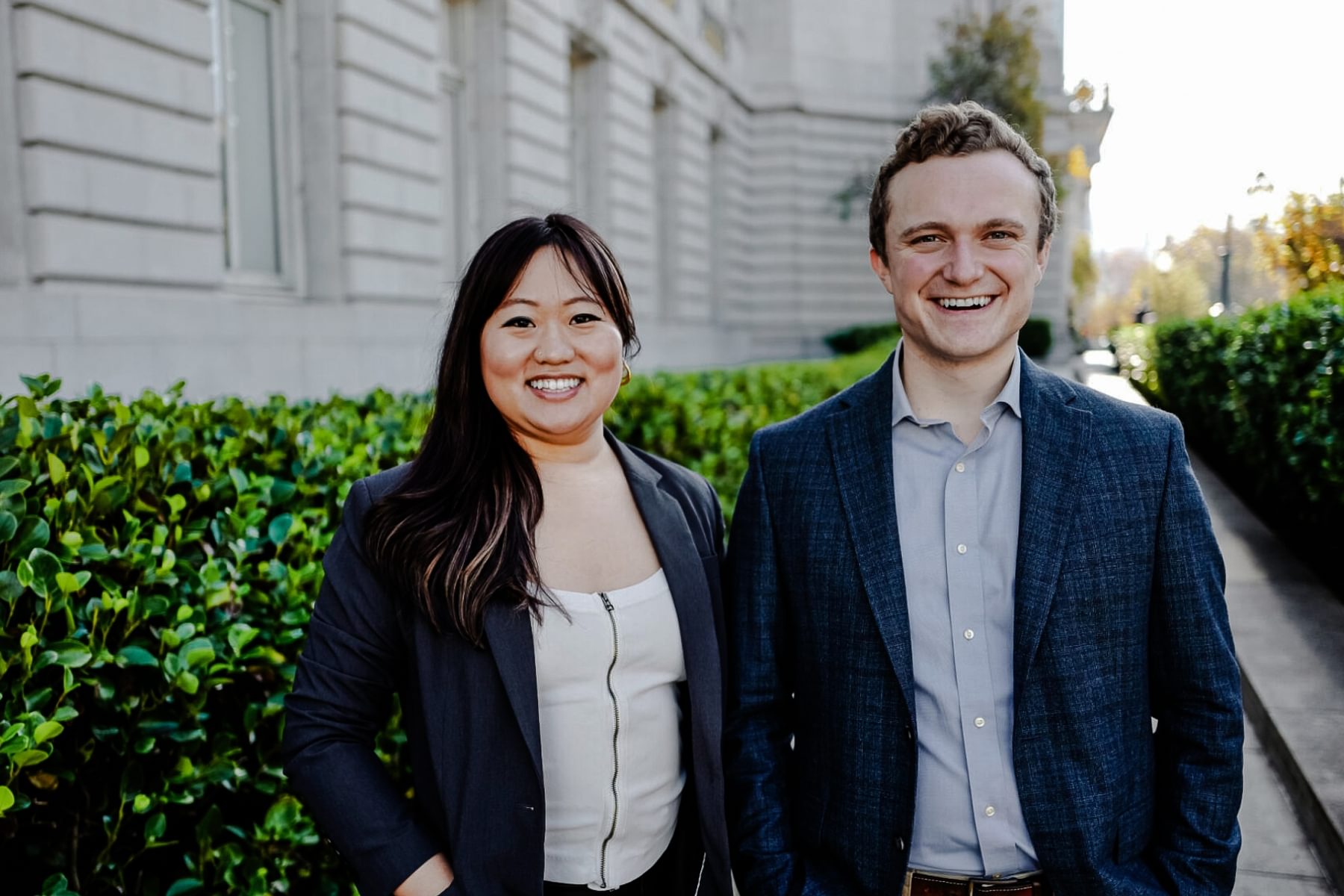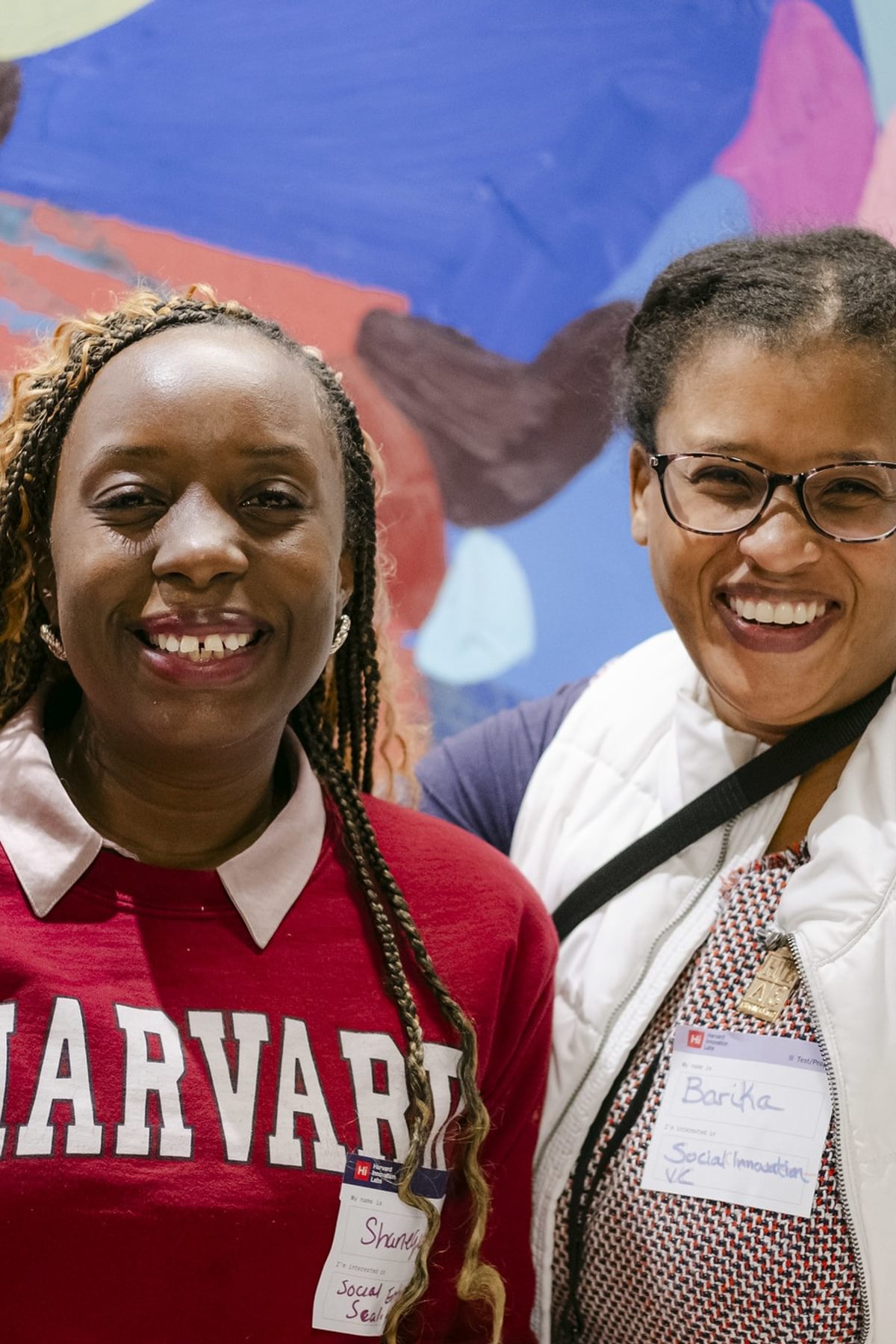When temperatures soar into the mid-80s in April across New England, some may relish the early sense of summer, but entrepreneurs working to address climate change hunker down.
In celebration of Earth Day, the Harvard Innovation Labs caught up with two recent winners of the President’s Innovation Challenge Ingenuity Award, which celebrates high-potential ideas and funds early-stage ventures, and two members of the 2023 Harvard Climate Entrepreneur’s Circle, a selective incubation program for high-potential ventures working to address climate change.
We asked them about their ventures, how they got involved in the sustainability space, and what advice they’d share with fellow Harvard founders who wish to address climate change.
Alex Berkowitz: Founder, Coastal Protection Solutions, Inc.
When Hurricane Sandy hit the coast of New York in 2012, Alex Berkowitz witnessed the devastating effects of climate change firsthand. Now, more than 10 years later, the Graduate School of Design student is developing a patent-pending system to protect vulnerable coastlines from extreme weather events and dangerous flooding. Alex is a 2023 Climate Circle venture. She also was a semifinalist in this year’s President’s Innovation Challenge, and she won both an Ingenuity Award and a Spark Grant in 2022.
As graduation approaches this May and she prepares for prototype testing this summer, Alex reflects on founding Coastal Protection Solutions, Inc. as a full-time student and offers advice to fellow students looking to tackle climate change with their own ventures.
What does your venture do?
Coastal Protection Solutions, Inc. specializes in easily deployable systems that mitigate the effects of climate change on coastal communities. We have developed a patent-pending system called The Wavebreaker which acts like a “wave speedbump” to decrease the height and velocity of waves during storms. With this new system, we hope to mitigate damage to life and property on shore and decrease coastal erosion.
What is the problem you’re trying to solve? And what impact are you hoping to achieve?
As extreme weather events become more commonplace due to climate change, coastal communities need to be better prepared to withstand them. Traditionally, coastal protection has taken the form of carbon-heavy concrete walls, which cost millions to produce, take years to build, and use outdated technology. We have designed an affordable floating breakwater that can be installed within days and moved, if necessary, to optimize effectiveness. Soon, communities that previously could not afford to protect themselves using traditional methods will be able to use our affordable technology that is disrupting the field of coastal adaptation.
What inspired you to start your venture? How did you get involved in climate work?
I was personally affected by climate change in 2012 when my hometown of Rockaway Beach, New York, was devastated by Hurricane Sandy. My family’s home was flooded with nine feet of water, and my neighbor’s home was featured in a Red Cross TV ad showcasing the destruction. I recall that some of my neighbors hid in their attics the night before the storm, unsure if they would even survive. The next morning, my street, which was always filled with kids laughing and playing, looked like a war zone. That day I vowed to find a solution that would protect communities like mine from such destruction.
Fast forward to today, and sadly, my community is just as vulnerable as on that October day; all of the proposed coastal protection projects were too grand and too expensive. The Wavebreaker is the solution to the impasse I have witnessed: It is nimble, affordable, and can be scaled up quickly. The Wavebreaker shears the height of a wave in half, and it can be installed in days, not years, so coastal communities can be ready when storms come.
What’s been the most challenging part about building your venture? The most rewarding?
The most challenging part of building my venture is working on it full time while I’m in school full time. I run from meetings with engineers to class and back to meetings with professors to talk about the project. Building a venture and a team to support it is a nonstop effort, so I need to be really intentional with managing my schedule. But to be honest, even the long hours can be fun when I’m working on my passion.
The most rewarding part of building a venture is having my work validated by experts in the field. For example, I went to the Netherlands this summer to meet with coastal engineering professors at Delft University of Technology, many of whom served on the committees to rebuild New York after Sandy. We had some incredible discussions about my projects and what they see as the future of coastal defense. I felt validated by the top experts in the world and felt the support I needed to accelerate production of The Wavebreaker, get it into the ocean, and start protecting communities.
What lessons/advice would you share with Harvard students or alumni innovators who wish to address climate change with their venture?
Stop hesitating. If we are going to survive the threat of climate change, we need all hands on deck. If you have an idea, talk it through with a member of the i-lab staff. Talk to your friends and your network to see if others want to join you. It takes a lot of courage to build out an idea, but if it turns out to be game-changing, then the leap of faith was worth it. It’s the people coming out of Harvard who have the passion and talent to make change and there’s no time to waste.

Ian Speers: Founder, Pacto Medical
Meet Ian Speers. He’s the charismatic founder behind Pacto Medical, a medical supply company that produces a collapsible syringe that makes the transportation of vaccine and other important public-health injections by reducing the packaging footprint. The result is less shipping costs, less environmental impact, and more prefilled syringes in the hands of patients who need them in countries around the world.
Harvard Innovation Labs recently caught up with Ian, a 2022 graduate of the Harvard T.H. Chan School of Public Health, on the heels of hitting three motivating milestones this March for Pacto Medical, which he cofounded with Robert Halvorsen and Ryan Stinebaugh. The team recently filed for a provisional U.S. patent; received a Spark Grant; and won an Ingenuity Award, which celebrates high-potential ideas and provides funding to early-stage ventures as part of the Harvard Innovation Labs’ President’s Innovation Challenge.
What does your venture do?
We invented a collapsible syringe for public health workers with a 40% smaller packaging footprint. Our design saves shipping costs, reduces environmental impact, and brings the safety and quality benefits of prefilled syringes to more patients around the world.
What problem are you trying to solve and what impact are you hoping to achieve with your venture?
Though prefilled syringes provide many benefits, the switch away from using vials to fill empty syringes has caused fewer syringes to fit on shipping pallets than before. Prefilled syringes come fully extended and take up more space during both bulk shipping and personal transport in backpacks and medical bags. To solve this, we’ve invented a collapsible syringe with a 40 percent smaller packaging footprint relative to traditional prefilled syringes.
What inspired you to start your venture? How did you get involved in climate work?
Before coming to HSPH, I worked in healthcare as an EMT for over 10 years and managed public health and emergency response programs, primarily in Africa and the Middle East, for four years. As a trained medical logistician, part of my work was focused on strengthening supply chain and medical logistics systems in low-resource settings. I experienced firsthand the compounding effect that small budgets, expensive transport, limited storage, and long travel distances have on an already challenging medical supply chain. For example, transporting just a few boxes of prefilled syringes to a rural clinic requires immense work and resources, while each box only contains about 30 syringes.
With each box that arrived, the wasted space and environmental impact became more and more apparent. This is because prefilled syringes, like many medical devices and supplies, are not optimized for clinical and/or logistical use in such settings. By focusing on this definable and tangible challenge, we invented a prefilled syringe that better responds to the healthcare needs in these settings with a smaller environmental footprint. The current designs have extended plunger rods that waste almost half of the space in each box.
Read more about Pacto Medical’s origin story.
What’s been the most challenging part about building your venture? The most rewarding?
The most challenging part of building this venture has been pushing past our own and other people’s ideas of who can innovate within the complex – and, at times, daunting – medical supply industry. While we receive a lot of excitement and enthusiasm for our product, many people are initially concerned that we won’t be able to penetrate the vertically integrated and mature prefilled syringe market, currently dominated by a handful of large companies.
The most rewarding part of this venture has been talking to countless end users around the world who are impacted by the challenges we are seeking to address at Pacto Medical. When we explain and present our invention to them, in an effort to gather their feedback and advice, their reactions and excitement about our solution make everything worthwhile and remind us of the impact this can have.
What lessons/advice would you share with fellow Harvard founders who wish to address climate change with their venture?
No matter what initial challenge you come to the table trying to solve, make sure that you map out and think about the climate implications of both the status quo and your proposed solutions. Climate change needs to be thought about early and often in this way and we cannot afford for it to be an afterthought or tack-on to a venture, innovation, or proposal. While everyone might not share that view or be as passionate as you are about addressing climate change, don’t let that dissuade you from keeping it as a focus of your work. Finally, make sure to connect and work with other like-minded people – take advantage of the climate-focused resources and organizations out there and don’t hide in a bubble. For example, connect with GreenProBono, Harvard Alumni for Climate and the Environment, and the Harvard Climate Entrepreneurs Circle, to name a few.

Abhishek Desai: Founder, S.A.L.Tech (Sustainable Architecture Landscape Technology)
As shoppers become more climate-conscious, many are searching for clothing made from sustainable fabrics. Cue Abhishek Desai, a Graduate School of Design student and fourth-generation aquafarmer who is turning seaweed into fashion.
He says it’s high on comfort and low on environmental impact, which made us want to learn more about this venture that recently took home an Ingenuity Award.
How would you summarize what your venture does?
S.A.L.Tech aims to produce seaweed fabrics to help decarbonize the fashion industry.
What is the problem you are trying to solve? And what are you hoping to achieve?
The fashion industry accounts for 10 percent of total carbon emissions every year. Alternative sustainable fabrics available in the market, such as hemp and flax, are labeled as sustainable but consume huge spans of agricultural land for their production. This practice promotes monoculture and leads to biodiversity loss, which is extremely detrimental to the environment. We at S.A.L.Tech aim to make available a new fabric alternative made from seaweed that is sustainable in a true sense: Seaweed uses the least amount of freshwater for its production, it does not require deforestation of the natural landscapes, and it has the highest ton per hectare production when compared to other sustainable materials.
What inspired you to start your venture? How did you get involved in climate work?
As a fourth-generation aquafarmer/salt farmer, I experience global warming in its physical form on a daily basis, from increased temperatures to groundwater depletion to polluted coastal waters. While studying landscape architecture at Harvard, we figured out that seaweed farming not only provides economic opportunities for farmers, but also has higher carbon sequestration capacities. This led to the exploration of the various seaweed plant species and the potential to decarbonize the coastal landscape. We believe at S.A.L.Tech that seaweed fabric is the answer for addressing climate change by preserving our natural landscapes without sacrificing comfort.
What has been the most challenging part about building your venture? The most rewarding?
It has been exciting to bring together a team of professionals from landscape and environmental studies, as well as urban design, to build a climate-focused venture with a global impact. But as young professionals, understanding patents from the biotech industry and creating a road map to even get a sample made were challenges for us.
What lessons/advice would you share with fellow Harvard founders who wish to address climate change with their venture?
Once you understand the urgency of climate change, one tends to analyze the most effective and impactful way to counter this overwhelming problem. The sheer volume of data available on this can be intimidating and confusing. Our biggest take away from this process was to start working on the ideas you feel most passionate about and not get caught up in analyzing how to solve all the problems related to climate change at once. All efforts, however small, are and will get channeled towards the bigger goal.

Chidalu Onyenso: Founder, Earthbond
Meet Chidalu Onyenso, the CEO and founder of Earthbond, a venture taking retail energy demand and coupling it with a user’s financial profile to qualify and offer financing for top-quality solar in Nigeria. A 2023 Climate Circle venture, Earthbond was named a finalist in Harvard Business School’s New Venture Competition and a semi-finalist in the President’s Innovation Challenge and the Climate and Sustainability Conference.
The Harvard Innovation Labs connected with Chidalu ahead of Earth Day to learn more about her venture and why she chose to build sustainability into her business model.
What does your venture do?
Earthbond leverages carbon accounting and development finance to build a clean energy fintech solution for urban Africans. We capture the energy demand and financials of small to mid-sized businesses to design the right-sized solar solution for their needs with a payment plan that fits their wallet.
What is the problem you’re trying to solve? And what impact are you hoping to achieve?
Due to poor power supply in the region, Africans businesses lose $100 billion a year and Nigerian businesses lose $29 billion of that. Small and medium-sized Nigerian businesses struggle to power their operations due to incessant power cuts coupled with expensive, and volatile, fuel costs for privately owned generators. Today, business owners spend $15 billion a year on fuel alone. Because of the prohibitive costs of fuel and the need to fund backup energy, many small businesses are forced to close operations. By helping to transition them to solar, which has a cheaper cost of lifetime ownership, we could help small businesses make more and save more while also reducing their carbon footprint.
What inspired you to start your venture? How did you get involved in climate work?
Initially, my focus was to find a sensible solution to Nigeria’s power issues, and so I tested out my idea last summer through the Rock Fellowship. From a climate perspective, Nigeria, and Africa more broadly, contribute less than four percent of greenhouse gas emissions globally, so my initial purpose wasn’t to target the continent’s carbon footprint as its most pressing issue.
However, Africa soon will be home to seven of the 10 most climate-vulnerable countries, so building resilience and adaptation to climate risk is even more urgent. Energy grids will become more vulnerable under extreme heat, and urbanization caused by climate-induced migration will add even more pressure. In this way, distributed energy solutions are core to African cities’ climate adaptation plans.
What’s been the most challenging part about building your venture? The most rewarding?
Balancing a rewarding MBA experience with being an Africa-centered founder has been challenging. I must make a lot of tradeoffs with my time, social experiences, and academics. But it’s also been incredibly exciting to find our first partners and complete our first customer’s installation. As a founder, I really get to see the payoff going from 0 to 1.
What lessons/advice would you share with Harvard students or alumni innovators who wish to address climate change with their venture?
The maths make sense. And if your morality aligns, then it becomes a why-not situation. I think climate will have a huge impact everywhere: in financial markets when evaluating risk, in operating businesses when looking at real assets and supply chains, and finally with end consumers who will need to change their behaviors to deal with extreme weather events and new phenomena. Take whatever you are interested in already and ask yourself: How will climate change, instability, and uncertainty change how this works? That’s the perfect place to start building.






